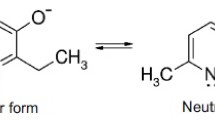Abstract
In vivo administration of 2,3,7,8-tetrachlorodibenzo-p-dioxin (TCDD) to rats produced significant alterations in Na-K, Ca, Mg ATPase and protein kinase activity, and receptor binding activity to insulin, concanavalin A, glucagon and epidermal growth factor in the canaliculi-rich plasma membrane fraction of the hepatocytes. Some of the changes are dose-related, and generally follow the time course of the sign of TCDD poisoning in the rat (e.g., the loss in body weight). Such TCDD-induced changes in membrane proteins and subsequent alteration in membrane functions appear to be extensive.
Similar content being viewed by others
References
Blair EH (ed) (1973) Chlorodioxins-Origin and Fate (Advances in Chemical Series 120), American Chemical Society, Washington, DC, 313 pp
Brewster DW, Madhukar BV, Matsumura F (1982) Influence of 2,3,7,8-TCDD on the protein composition of the plasma membrane of hepatic cells from the rat. Biochem Biophys Res Commun 107:68–74
Bumb RR, Crummett WB, Cutie SS, Gledhill JR, Hummel RH, Kagel RO, Lamparski LL, Luoma EV, Miller DL, Nestrick TJ, Shadoff LA, Stehl RH, Woods JS (1980) Trace characteristics of fire. A source of chlorinated dioxins. Science 210:385–394
Chandramouli V, Williams S, Marshall JS, Carter Jr. JR (1977) Cell surface changes in diabetic rats. Studies of lectin binding to liver cell plasma membranes. Biochim Biophys Acta 465:19–33
Corbin JD, Reiman EM (1974) Assay of c-AMP dependent protein kinases. In: Hardman JG, O'Malley BW (eds) Methods in Enzymology. Academic Press, New York, 38:287–290
Gasiewicz TA, Olson JR, Gieger LE, Neal RA (1983) Absorption, distribution and metabolism of 2,3,7,8-tetrachlorodibenzo-p-dioxin (TCDD) in experimental animals. In: Tucker RE, Young AL, Gray AP (eds) Human and Environmental Risks of Chlorinated Dioxins and Related Compounds. Plenum Press, New York, pp 495–525
Gupta BN, Vos JG, Moore JA, Zinkl JG, Bullock BC (1973) Patholgoical effects of 2,3,7,8-tetrachlorodibenzo-p-dioxin in laboratory animals. Environ Health Perspect 5:125–140
Harris MW, Moore JA, Vos JG, Gupta ABN (1973) General biological effects of TCDD in laboratory animals. Environ Health Perspect 5:101–109
Hook GER, Haseman JK, Lucier GW (1975) Induction and suppression of hepatic and extra-hepatic microsomal foreign-compound-metabolizing enzyme systems by 2,3,7,8-TCDD. Chem-Biol Interact 10:199–214
Kociba RJ, Keyes DG, Beyer JE, Carreon RM, Wade CE, Dittenber D, Kalnins R, Frauson L, Park CN, Bernard S, Hummel R, Humiston CG (1978) 2,3,7,8-Tetrachlorodi-benzo-p-dioxin (TCDD): Results of a 13-week oral toxicity study in rats. Toxicol Appl Pharmacol 46:279–303
Matsumura F, Clark JM (1980) ATPases in the axon-rich membrane preparation from the retinal nerve of the squid,Loligo paelei. Comp Biochem Physiol 66B:23–32
Madhukar BV, Matsumura F (1979) Comparison of induction patterns of rat hepatic microsomal mixed-function oxidases by pesticides and related chemicals. Pestic Biochem Physiol 11:301–308
McConnell EE, Moore JA (1978) The toxicopathology of TCDD. In: Cattabeini F, Cavallara A, Galli G (eds) Dioxin, Toxicological and Chemical Aspects (Monogram of the Giovanni Lorenzini Foundation), Spectrum Publications, New York, pp 137–141
Neal RA, Beatty PW, Gasiewicz TA (1979) Studies of the mechanisms of toxicity of 2,3,7,8-tetrachlorodibenzo-p-dioxin (TCDD). Ann NY Acad Sci 320:204–213
Nebert DW (1979) Genetic differences in the induction of monooxygenase activities by polycyclic aromatic compounds. Pharmacol Ther 6:395–417
O'Keefe E, Hollenberg MD, Cuatracasas P (1974) Epidermal growth factor characteristics of specific binding in membranes from liver, placenta, and other target tissues. Arch Biochem Biophys 164:518–526
Peterson RE (1981) Retrodifferentiation: A mechanism for the depression of ouabain biliary excretion in male rats treated with 2,3,7,8-tetrachlorodibenzo-p-dioxin. In: Khan MAQ, Stanton RH (eds) Toxicology of Halogenated Hydrocarbons: Health and Ecological Effects, Pergamon Press, New York, pp 133–145
Peterson RE, Madhukar BV, Yang KH, Matsumura F (1979a) Depression of adenosine triphosphatase activities in isolated liver surface membranes of 2,3,7,8-tetrachlorodibenzo-p-dioxin-treated rats: correlation with effects on ouabain biliary excretion and bile flow. J Pharmacol Exp Ther 210:275–282
Peterson RE, Hamada N, Yang KH, Madhukar BV, Matsumura F (1979b) Reversal of 2,3,7,8-tetrachlorodibenzo-p-dioxin-induced depression of ouabain biliary excretion by pregnenolone-16 -carbonitrile and spironolactone in isolated perfused rat liver. Toxicol Appl Pharmacol 50:407–416
Poland A, Glover E (1974) Comparison of 2,3,7,8-tetrachlorodibenzo-p-dioxin, a potent inducer of aryl hydrocarbon hydroxylase, with 3-methylcholanthrene. Mol Pharmacol 10:349–359
Poland A, Glover E, Kende KS (1976) Stereospecific, high affinity binding of 2,3,7,8-tetrachlorodibenzo-p-dioxin by hepatic cytosol. J Biol Chem 251:4936–4946
Poland A, Kende A (1976) 2,3,7,8-Tetrachlorodibenzo-p-dioxin: Environmental contaminant and molecular probe. Fed Proc 35:2404–2411
Schwetz BA, Norris JM, Sparchu GL, Row VK, Gehring PJ, Emerson JL (1973) Toxicology of chlorinated dibenzo-p-dioxins. Environ Health Perspect 5:87–99
Seefeld MD, Corbett SW, Keesey RE, Peterson RE (1982) Comparison of body weight loss and oxygen consumption in rats treated with 2,3,7,8-tetrachlorodibenzo-p-dioxin (TCDD) and pair-fed control rats. Toxicologist 2:131 (Abstract 462)
Tate SS, Meister A (1974) Interaction of -γ-glutamyl transpeptidase with amino acids, dipeptides, and derivatives and analogs of glutathione. J Biol Chem 249:7593–7602
Vos JG, Moore JA, Zinkl JG (1973) Effect of 2,3,7,8-tetrachlorodibenzo-p-dioxin on the immune system of laboratory animals. Environ Health Perspect 5:149–162
Yunghans WN, Morré DJ (1973) A rapid and reproducible homogenization procedure for the isolation of plasma membrane from rat liver. Prep Biochem 3:301–312
Author information
Authors and Affiliations
Rights and permissions
About this article
Cite this article
Matsumura, F., Brewster, D.W., Madhukar, B.V. et al. Alteration of rat hepatic plasma membrane functions by 2,3,7,8-tetrachlorodibenzo-p-dioxin(TCDD). Arch. Environ. Contam. Toxicol. 13, 509–515 (1984). https://doi.org/10.1007/BF01056330
Received:
Revised:
Issue Date:
DOI: https://doi.org/10.1007/BF01056330



